The sign on the shoulder of SR 49 in California’s Sierra Nevada foothills read, “Entering 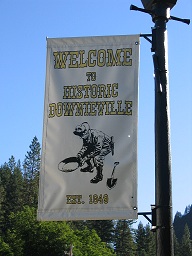 Downieville.” On the other side of the same sign it said, “Leaving Downieville, Thanks for Coming.”
Downieville.” On the other side of the same sign it said, “Leaving Downieville, Thanks for Coming.”
Okay, I’m totally kidding here. No town is that small. But Downieville is…well, pretty small. I went up there last summer for final research on my novel, The Burning Ground, which will be published on Valentine’s Day this year. (A ghost story on Valentine’s Day; go figure.) After mile upon twisting mile of nothing but trees, rocks, and tributaries, I suddenly found myself in the heart of “downtown” Downieville. Before I even had a chance to slow down and look for my inn I had crossed a one-lane truss bridge and was back amid nature, on my way up to the next town. Whoops, back I went. Not easy making a u-turn on a mountain road.
I had come across Downieville, noted on various websites and in guide books as a “semi-ghost” town (population 325, give or take), during my preliminary research for The Burning Ground. Seems I needed a model for my fictional town of Lodestar, where most of the story takes place. The location I envisioned, on or near either the middle or north fork of the Yuba River, made Downieville a candidate. But there were others: Nevada City, Grass Valley, Sierra City, just to name a few.
So why did I keep coming back to Downieville? Maybe it was the “semi-ghost” part, for obvious reasons. Or maybe the fact that the town was founded in 1849, the year in which my opening chapter takes place. In a nod to my 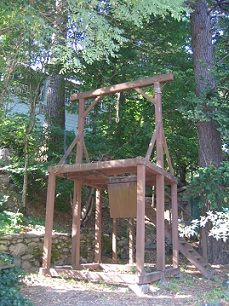 morbid side, perhaps it had to do with Downieville being the only town in California to have ever hung a woman. (I even saw the gallows there, or a reasonable facsimile.)
morbid side, perhaps it had to do with Downieville being the only town in California to have ever hung a woman. (I even saw the gallows there, or a reasonable facsimile.)
Whatever the case, here I was, for the better part of four days, in the venerable town of Downieville, surrounded by the majesty of California’s Sierra Nevada mountains. What I absorbed there—what I saw, heard, smelled, touched—brought the setting of the fictional Lodestar to life in my subsequent third and final draft of The Burning Ground.
And as a topper, something really weird happened on my second day there…
First things first, though. I saw buildings that had gone up with the founding of the town. I sat on the bank of the swiftly flowing Yuba River’s north fork, where miners had once dug up gold nuggets the size of softballs. Climbing up a steep hill (this became routine), I visited the “Masonic Graveyard, Circa 1860.” I stopped at the offices of the Mountain Messenger, “California’s Oldest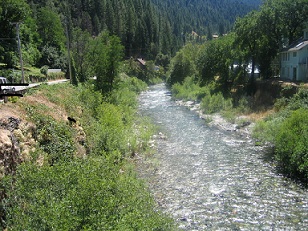 Newspaper,” and talked to the editor, Don Russell. (Same name as one of the characters in my last novel, Fire Dance—moderately weird.) The “Mayor” of Downieville, an elderly gent named Dave Farmer, invited me to lunch and was a fount of information, as was Dave Marshall at the Sierra County Museum. (I thanked him by purchasing one of the museum’s tee-shirts; never met a tee-shirt I didn’t like.) The list goes on.
Newspaper,” and talked to the editor, Don Russell. (Same name as one of the characters in my last novel, Fire Dance—moderately weird.) The “Mayor” of Downieville, an elderly gent named Dave Farmer, invited me to lunch and was a fount of information, as was Dave Marshall at the Sierra County Museum. (I thanked him by purchasing one of the museum’s tee-shirts; never met a tee-shirt I didn’t like.) The list goes on.
But you want to know about really weird, right? Okay, but in order for it to make sense, here is some backstory. You already know that The Burning Ground is about ghosts, and gold mining. The contemporary story takes place over a period of nine days encompassing Labor Day weekend 2012, with Lodestar hosting an annual event called Gold Rush Days, which brings hordes of tourists in to bolster the town’s economy. Many locals hang out at the Forty Rod Saloon (“forty rod” was cheap, nasty rotgut whiskey sold during the Gold Rush), where the owner sells souvenir bottles of forty rod, “Just like the miners used to drink,” to the tourists. Bottles of it line shelves behind the bar, in front of an ornate mirror. The building itself is an old western-style saloon, swinging doors and everything. The saloon is where one of the story’s most intense scenes takes place.
Okay, so I’m wandering up (or possibly down) another hill a couple blocks from downtown when I spot an old, western-style saloon—in miniature. Yep, swinging doors and everything. The Forty Rod Saloon, just as I’d envisioned it. I want to take a photo, but I see a woman inside, and out of courtesy I walk into the small place—there’s an 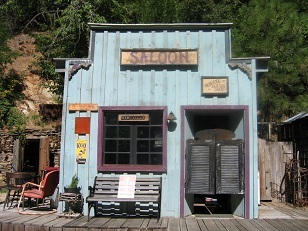 ornate mirror behind the bar and shelves with whiskey bottles lined up—and ask her if that would be all right. Cherry Simi, the proprietor of the mini-saloon (it’s not a working bar, she tells me, just a place for town meetings and other social gatherings), is fine with that but wonders about my interest. So I tell her who I am and what I’m doing, and also a bit about my book. She thinks this is pretty cool. Then she tells me about an old mining tunnel that runs from the back of the saloon up to her house. With much enthusiasm she asks me, “Wanna see it?”
ornate mirror behind the bar and shelves with whiskey bottles lined up—and ask her if that would be all right. Cherry Simi, the proprietor of the mini-saloon (it’s not a working bar, she tells me, just a place for town meetings and other social gatherings), is fine with that but wonders about my interest. So I tell her who I am and what I’m doing, and also a bit about my book. She thinks this is pretty cool. Then she tells me about an old mining tunnel that runs from the back of the saloon up to her house. With much enthusiasm she asks me, “Wanna see it?”
After a brief bout with the willies and a silent plea for Masters Yoda and Obi Wan to protect my butt, I follow her in. The wide tunnel is neat, even more so when I see what Cherry has lined the walls with: ghosts and skeletons! Yeah, I could hardly believe it either.
But it doesn’t end there. We go back inside the mini-saloon, and Cherry mentions that it’s pretty quiet in town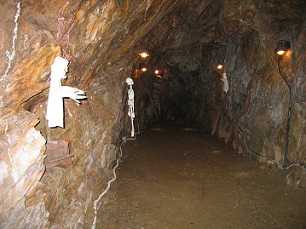 during mid-summer, as I probably noticed. She suggests I come back up when things get busier, over Labor Day weekend the following month. “Uh, Labor Day?” I mumble. “What happens then?”
during mid-summer, as I probably noticed. She suggests I come back up when things get busier, over Labor Day weekend the following month. “Uh, Labor Day?” I mumble. “What happens then?”
The town hosts a festival, she tells me. It’s called—Gold Rush Days.
No, I’m not making this up. And if you’re thinking that I probably saw it in my preliminary research and just forgot about it, wrong-o. Upon returning home I went through everything I’d read or downloaded, thinking the same thing, but the only event of significance mentioned was Downieville’s annual mountain bike race earlier in the summer.
This isn’t the first time something like that happened to me while researching my books. Maybe I’ll write about other really weird experiences another time. Just remember, when you engage in “living research,” as I call it, just open up your mind and be prepared for anything.
And when you’re in Lodestar, California while reading The Burning Ground, remember its prototype—the historic, semi-ghost town of Downieville.

It was a pleasure to meet you, Mike, and I look forward to reading your novel! Thank you for mentioning me on your blog, and I’m glad you found Downieville to be the perfect fit for Lodestar. Hope you’ll make another trip to visit; maybe you’ll find something of interest for the next novel! The “Simiville Saloon” is always open for you!
You also got a mention in the book’s Acknowledgements, Cherry. Thanks for the tour. My trip to Downieville was one of the highlights of 2011!
Cherry, That hill behind the saloon looks suspiciously like the one I ran down as a child across the street from my grandparents old house. But…that building was not there. Is it next to the old Chinese laundry?
Diana,
Yes, the photo is of our property which is formerly known as the Downieville Brewery, aka Bosch Brewery, aka ” old Chinese laundry” ! The mining tunnel has been there since the 1850’s , and the saloon is a replica building that we built several years ago.
So when does the book come out? And Cherry, how come you never told me about the mine tunnel? I had to hear of it from Rick.
The Burning Ground is already out, Don. Enjoy. 🙂
Thanks. I’ll check Amazon.
The book came out Feb. 14 and is available on Amazon and at many bookstores. Mine came from Amazon, courtesy of my brother-in-law, who said he had a hard time putting it down once he started reading it. The book has an interesting plot and the location, Lodestar, is based on Downieville. It will be fun to read this fictional novel and I enjoyed chatting with the author, Mike Sirota .
Thanks Cherry. I just found it on Amazon. Did I hear you might be a character in the book? 🙂
Very nice article. I think the woman (Juanita I believe her name was, although I could be wrong) was hung from the bridge near the gallows, not actually the gallows. I suppose I could be wrong, but that’s what I was told. Thank you for appreciating the specialness of our little county seat. I’ll check out your book.
Thanks, Janice. Yes, her name was Juanita, and I know that wasn’t the actual gallows, but it’s still pretty creepy. I loved visiting your town, and I hope you enjoy the book.